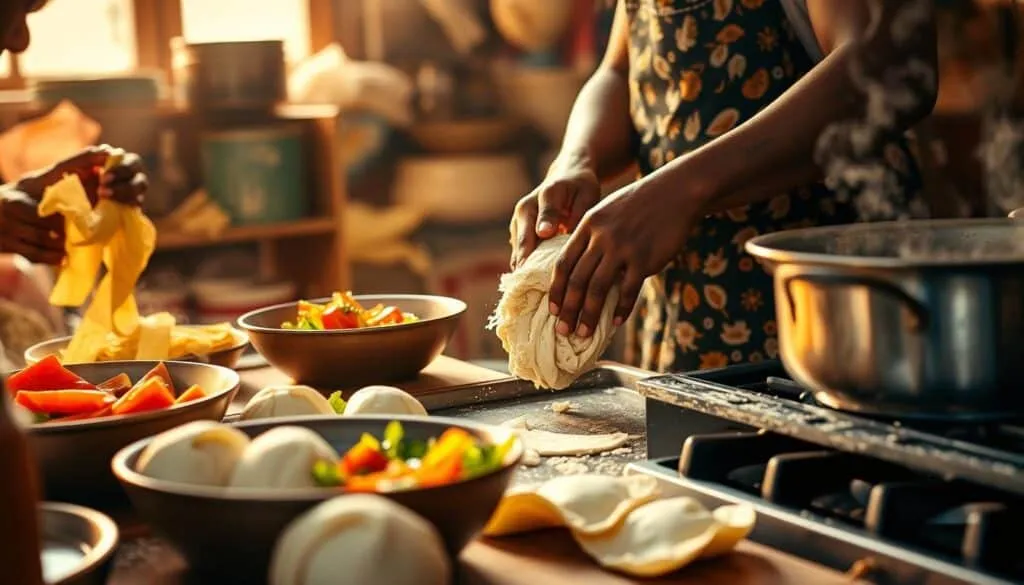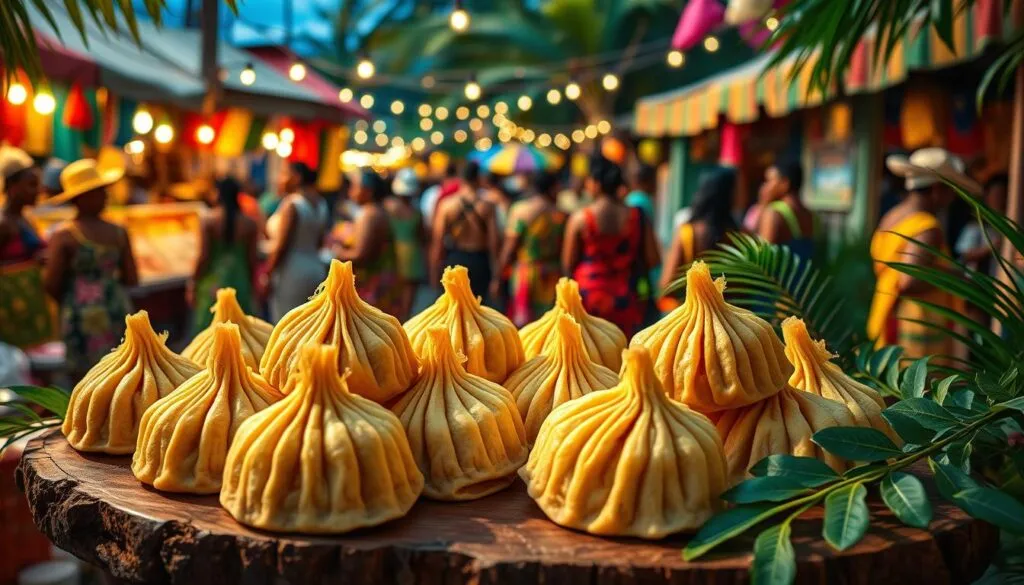Jamaican Pepper Shrimp Recipe
Indulge in the rich flavors of the Caribbean with a traditional dish that’s both crispy and soft – Jamaican Festival Fried Dumplings. These golden delights are a staple in Caribbean cuisine, offering a taste experience that’s both lightly sweetened and irresistibly tender.
The cultural significance of these dumplings runs deep, making them a must-try for anyone looking to explore traditional Jamaican food. With their unique blend of textures and flavors, they’re sure to leave you wanting more.
Key Takeaways
- Discover the unique taste of Jamaican Festival Fried Dumplings.
- Explore the cultural significance of this traditional Caribbean dish.
- Learn how to make this delicious treat at home.
- Understand the importance of Jamaican Festival Dumplings in Caribbean cuisine.
- Experience the blend of crispy and soft textures in one dish.
What Are Jamaican Festival Dumplings?
Jamaican Festival Dumplings, often enjoyed with escovitch fish or jerk chicken, embody the spirit of Jamaican culinary traditions. These dumplings are a staple in Jamaican cuisine, reflecting the island’s cultural heritage through their unique flavor profile.
A Brief History of Festival Dumplings
The origins of Jamaican Festival Dumplings are deeply rooted in traditional Jamaican cuisine, where dumplings have been an integral part of the culinary tradition for generations. The specific version known as “festival” is believed to have evolved as a street food, designed to be easy to eat and flavorful.
According to culinary historians, the introduction of dumplings in Jamaica was influenced by cultural exchanges, including those with African and British cuisines. This blend of influences resulted in a distinctively Jamaican recipe that is both sweet and savory.
“The beauty of Jamaican Festival Dumplings lies in their simplicity and the way they complement a variety of dishes, from jerk meats to seafood.”
Cultural Significance in Jamaican Cuisine
Jamaican Festival Dumplings hold a special place in the hearts of Jamaicans, often serving as a comfort food that evokes memories of family gatherings and celebrations. They are a testament to the resourcefulness and creativity of Jamaican cooking, utilizing basic ingredients to create something truly delightful.
| Cultural Aspect | Significance |
|---|---|
| Family Gatherings | Festival Dumplings are often served at family gatherings, reinforcing their role in Jamaican social culture. |
| Culinary Tradition | They represent a continuation of traditional Jamaican cooking methods and recipes. |
| Street Food | As a popular street food, Festival Dumplings are accessible to everyone, embodying the spirit of Jamaican hospitality. |
The cultural significance of Jamaican Festival Dumplings is further underscored by their presence at various celebrations and festivals throughout the island. They are a culinary delight that brings people together and celebrates Jamaica’s rich heritage.
Key Ingredients for Jamaican Festival Dumplings
To make authentic Jamaican Festival Dumplings, understanding the role of each ingredient is essential. The beauty of this traditional dish lies in its simplicity, with each component playing a vital role in the final product.
Flour and Cornmeal: The Base of the Recipe
The primary ingredients in Jamaican Festival Dumplings are all-purpose flour and cornmeal. All-purpose flour provides structure, while cornmeal adds a unique texture and flavor. The combination of these two ingredients creates a dumpling that is both tender and slightly crispy.
“The use of cornmeal is what sets Jamaican Festival Dumplings apart from other dumpling recipes,” notes a culinary expert. “It’s a testament to the resourcefulness of Jamaican cuisine, utilizing local ingredients to create something truly special.”
The Role of Sugar and Baking Powder
Sugar and baking powder are also crucial ingredients in the recipe. Sugar adds a hint of sweetness, balancing the savory flavors, while baking powder is essential for the dumplings to rise, giving them a light, airy texture.
- Sugar: Adds sweetness and helps in browning.
- Baking powder: Enables the dumplings to rise, making them fluffy.
By understanding the role of each ingredient, you can make easy festival dumplings that are not only delicious but also authentic. The key is to balance these ingredients correctly to achieve the perfect homemade dumplings.
Step-by-Step Preparation of Festival Dumplings
Jamaican Festival Dumplings are a delight to make, and with this step-by-step guide, you’ll achieve perfect results. The process involves mixing the right ingredients and shaping them into the signature dumplings.
Mixing the Dough: Tips for the Perfect Consistency
To start, combinethe dry ingredients, such as flour,cornmeal, sugar, and baking powder,in a large bowl. As Jamaican cooking tutorial experts suggest, it’s crucial to mix these ingredients thoroughly to avoid any lumps. Gradually add water to the dry mixture, stirring continuously until the dough comes together. The key is to achieve a dough that is not too sticky nor too dry. A good tip is to add water slowly and be prepared to adjust the consistency as needed.
“The secret to great dumplings lies in the dough. It should be smooth and pliable,” says a renowned Jamaican chef. Ensuring the right consistency is vital to the dumplings holding their shape during cooking.

Shaping the Dumplings: Form and Size Matter
Once the dough is ready, it’s time to shape the dumplings. Traditionally, Jamaican Festival Dumplings are made into elongated shapes, which helps them cook evenly. To achieve this, take a small portion of the dough and roll it between your hands until it forms a smooth, cylindrical shape. The size can vary, but they are typically around 3-4 inches long.
- Ensure the dumplings are evenly sized so that they cook at the same rate.
- Handle the dough gently to prevent it from becoming tough.
- Keep the shaped dumplings on a floured surface or tray, ready for cooking.
By following these steps and tips, you’ll be able to make homemade dumplings that are not only delicious but also visually appealing. The art of making festival dumplings is a skill that improves with practice, so don’t be discouraged if the first batch isn’t perfect.
Cooking Methods: Frying vs. Baking
The traditional method of frying Jamaican Festival Dumplings is often contrasted with a healthier alternative: baking. Both methods have their advantages, and the choice between them depends on personal preference and dietary needs.
Frying: The Traditional Approach
Frying is the conventional method for cooking Jamaican Festival Dumplings, yielding a crispy exterior and a fluffy interior. To achieve perfectly fried dumplings, it’s essential to heat the oil to the correct temperature.
Tips for Frying:
- Use the right oil: Vegetable oils with a high smoke point are ideal.
- Maintain the correct temperature: 350°F (175°C) is recommended.
- Don’t overcrowd the pot: Fry in batches if necessary.
Baking: A Healthier Alternative
Baking is a healthier option that still produces delicious results. It reduces the overall fat content of the dumplings and can be an excellent alternative for those seeking a lighter option.
Tips for Baking:
- Preheat your oven to 375°F (190°C).
- Brush the dumplings with a bit of oil to enhance browning.
- Space them out on a baking sheet to allow even cooking.
| Cooking Method | Advantages | Disadvantages |
|---|---|---|
| Frying | Crispy exterior, fluffy interior | Higher fat content requires careful temperature control |
| Baking | Healthier, less oil required | May lack the crispiness of fried dumplings |
Ultimately, whether you choose to fry or bake your Jamaican Festival Dumplings, the key to success lies in the preparation and attention to detail. Experiment with both methods to find your preferred way of enjoying this traditional Jamaican dish.
Flavoring Your Festival Dumplings
Jamaican Festival Dumplings are not just a side dish; they become a leading event when infused with the right flavors and sauces. The beauty of these dumplings lies in their versatility, which allows you to experiment with a variety of spices and dips characteristic of Caribbean cuisine.
Infusing Spices for Extra Taste
To give your Festival Dumplings an extra kick, you can infuse the dough with a blend of spices. Typical spices used include cinnamon, nutmeg, and a hint of allspice. These spices not only add warmth but also complement the sweetness of the dumplings, creating a balanced flavor profile.
For those looking to add a bit of heat, incorporating a small amount of Scotch bonnet pepper or Jamaican jerk seasoning into the dough can elevate the dumplings to a new level. However, it’s essential to use these ingredients sparingly to avoid overpowering the other flavors.
Common Dipping Sauces in Jamaica
In Jamaica, Festival Dumplings are often enjoyed with a variety of dipping sauces that enhance their flavor. One of the most popular accompaniments is sweet chili sauce, which adds a tangy, slightly spicy kick to the dumplings.
Another favorite is a simple mango salsa, made with diced mango, onions, peppers, and a squeeze of lime juice. This refreshing salsa pairs perfectly with the warm, fried dumplings, offering a delightful contrast of flavors and textures.
| Dipping Sauce | Main Ingredients | Flavor Profile |
|---|---|---|
| Sweet Chili Sauce | Chili peppers, vinegar, sugar | Tangy, slightly spicy |
| Mango Salsa | Mango, onions, peppers, lime juice | Fresh, fruity, slightly spicy |
| Jerk Sauce | Jerk seasoning, soy sauce, lime juice | Spicy, savory, aromatic |
Experimenting with different spices and dipping sauces can transform your Jamaican Festival Dumplings into a truly unforgettable culinary experience. Whether you prefer traditional flavors or want to experiment with new combinations, the key is to have fun and be creative in the kitchen.
Serving Suggestions with Festival Dumplings
Elevate your meal with Jamaican Festival Dumplings, a traditional delight. These dumplings are not just a side dish; they can be the centerpiece of your culinary experience, complementing a wide range of Jamaican dishes.
Pairing with Jerk Chicken
Jerk chicken and Festival Dumplings are a match made in heaven. The spicy, smoky flavor of jerk chicken pairs perfectly with the sweet, fried, or baked goodness of homemade dumplings. To make jerk chicken, marinate chicken pieces in a mixture of jerk seasoning, allspice, and thyme, then grill or bake until cooked through. Serve alongside your Festival Dumplings for a truly authentic Jamaican meal.
Complementing Traditional Jamaican Dishes
Festival Dumplings can complement a range of traditional Jamaican dishes beyond jerk chicken. They go well with escovitch fish, a spicy fish dish marinated in a mixture of vinegar, peppers, and onions. They also pair nicely with boiled green bananas or yams, making for a hearty and filling meal.
| Dish | Pairing Suggestion |
|---|---|
| Jerk Chicken | Classic combination with Festival Dumplings |
| Escovitch Fish | Spicy fish with a tangy twist |
| Boiled Green Bananas | A traditional side that complements dumplings well |
For an added twist, try serving your Festival Dumplings with a side of spicy mango salsa or a refreshing coleslaw made with red cabbage and carrots. The key is to experiment and find your favorite combinations.

Jamaican Festival Dumplings for Special Occasions
In Jamaica, festival dumplings are more than just a dish; they’re a centerpiece for celebrations. These dumplings are a staple at various special occasions, including festivals, family gatherings, and cultural events.
Festivals and Celebrations Featuring Dumplings
Jamaican festivals are renowned for their vibrant culture and delectable cuisine, with festival dumplings being a notable highlight. During events like the Jamaica Carnival or Reggae Sumfest, these dumplings are enjoyed by people of all ages. They are often served alongside other traditional dishes, creating a quintessentially Jamaican culinary experience.
Family Gatherings and Their Importance
Family gatherings in Jamaica are incomplete without festival dumplings—these occasions, whether weddings, birthdays, or holidays, areenhanced bytraditional foods. Festival dumplings serve as a connection to heritage and culture, bringing families together through the shared experience of enjoying a beloved dish.
The significance of festival dumplings in Jamaican culture is also reflected in their versatility. They can be enjoyed as a side dish, a snack, or even as part of a main course. This adaptability makes them a favorite among locals and visitors alike.
In summary, Jamaican Festival Dumplings are not just a tasty treat; they are an integral part of the island’s cultural fabric, especially during special occasions. Their presence at festivals and family gatherings highlights their significance in Jamaican culture.
Troubleshooting Common Dumpling Issues
Despite the simplicity of the recipe, homemade dumplings can sometimes turn out tough or greasy. Understanding the causes of these issues iscrucial to makingeasy,consistently enjoyable festival dumplings.
One of the most common problems encountered is toughness. Tough dumplings can be disappointing, but there are several strategies to prevent this.
What to Do if Your Dumplings Are Tough
Toughness in dumplings is often due to overworking the dough or using the wrong type of flour. To avoid this, it’s essential to mix the ingredients just until they come together and to use a combination of flour and cornmeal that provides the right texture.
- Use a gentle mixing technique to prevent gluten development in the flour.
- Choose the correct type of cornmeal; a finer grind can contribute to a tender dumpling.
- Don’t overwork the dough; stop mixing as soon as the ingredients are combined.
As a seasoned Jamaican chef once said,
“The secret to tender dumplings lies in the gentle handling of the dough.”
Fixing Overly Greasy Dumplings
On the other hand, greasiness is another issue that can make dumplings unappetizing. This is often due to incorrect frying temperatures or to not draining the dumplings properly after frying.
To fix overly greasy dumplings, ensure that your frying oil is at the right temperature before adding the dumplings. If the oil is too cold, the dumplings will absorb more oil than necessary.
- Use a thermometer to check the oil temperature; it should be around 350°F (175°C) for frying.
- Drain fried dumplings on paper towels to remove excess oil.
- Consider baking as an alternative to frying for a healthier option.
By following these tips, you can achieve perfectly cooked Jamaican Festival Dumplings that are neither tough nor greasy. For more detailed guidance, consider consulting a comprehensive Jamaican cooking tutorial that covers the nuances of traditional Caribbean cooking.
Nutritional Information and Health Benefits
Jamaican Festival Dumplings, a staple of Jamaican cuisine, offer a blend of nutrients that contribute to their health benefits. While they are often enjoyed for their taste, understanding their nutritional profile can add another layer of appreciation for this traditional dish.
Caloric Breakdown
The caloric content of Jamaican Festival Dumplings can vary based on the cooking method and ingredients used. On average, a single dumpling contains 150-250 calories. The majority of these calories come from carbohydrates, primarily from the flour and cornmeal.
Nutritional Content: A typical serving of 2-3 dumplings contains approximately 300-500 calories, with 60-80g of carbohydrates, 5-7g of protein, and 10-15g of fat.
Nutraceutics of Key Ingredients
The key ingredients in Jamaican Festival Dumplings, such as cornmeal and flour, offer various nutritional benefits. Cornmeal is a good source of fiber and minerals like selenium and iron.
Cornmeal Benefits: The fiber in cornmeal can aid digestion, while its antioxidants may contribute to overall well-being.
The addition of sugar and baking powder enhances the nutritional profile of the dumplings, albeit in moderation. Sugar provides a quick source of energy, while baking powder enhances the texture of the dumplings.
Inspiring Variations: Creative Takes on Festival Dumplings
Jamaican Festival Dumplings, a cornerstone of Caribbean cuisine, offer a versatile canvas for culinary creativity. As we’ve explored the traditional recipe and cooking methods, it’s time to push the boundaries and innovate.
Dessert Lovers’ Delight
Transforming homemade dumplings into a sweet treat is easier than you think. By incorporating fruits like blueberries or strawberries into the dough, or by adding a hint of cinnamon and nutmeg, you can create a dessert that’s both unique and delicious. These sweet dumplings can be served with a dollop of whipped cream or a drizzle of honey, perfect for a Jamaican festival-inspired dessert.
Savory Innovations
For those looking to add a savory twist to the traditional recipe, consider infusing the dumplings with herbs and spices commonly found in Jamaican cuisine. Chopped scallions, thyme, or a hint of garlic can elevate the flavor profile, making these dumplings an excellent accompaniment to a variety of savory dishes. Whether you’re serving them alongside jerk chicken or as part of a larger Caribbean-inspired meal, these delicious dumplings are sure to impress.
By experimenting with these variations, you can keep the spirit of the Jamaican festival alive in your kitchen, exploring new flavors and traditions that celebrate the richness of Caribbean cuisine.
FAQ
What are Jamaican Festival Dumplings?
Jamaican Festival Dumplings are a traditional Jamaican dish made from a mixture of flour, cornmeal, sugar, and baking powder, typically fried until golden brown and often served as a side dish or snack.
Can I bake Jamaican Festival Dumplings instead of frying them?
Yes, you can bake Jamaican Festival Dumplings as a healthier alternative to frying. Simply shape the dumplings as usual and bake in a preheated oven at 375°F (190°C) for about 20-25 minutes, or until golden brown.
What is the role of cornmeal in Jamaican Festival Dumplings?
Cornmeal adds a unique texture and flavor to Jamaican Festival Dumplings, providing a slightly sweet, gritty element that complements the other ingredients.
How do I achieve the perfect consistency for my dumpling dough?
To achieve the perfect consistency, ensure that your dough is not too wet or too dry. If it’s too wet, add a small amount of flour to thicken it. If it’s too dry, add a small amount of water. The dough should be pliable and easy to shape.
Can I flavor my Jamaican Festival Dumplings with spices?
Yes, you can infuse your Jamaican Festival Dumplings with spices to add extra flavor. Common spices used include nutmeg, cinnamon, and scotch bonnet peppers, which can be added to the dough for an extra kick.
What are some common dipping sauces for Jamaican Festival Dumplings in Jamaica?
In Jamaica, common dipping sauces for Festival Dumplings include jerk seasoning sauce, soy sauce, and a spicy mango salsa. You can also try using a simple mixture of ketchup and hot sauce for a quick and easy dip.
Are Jamaican Festival Dumplings suitable for special occasions?
Yes, Jamaican Festival Dumplings are often served at special occasions such as festivals, family gatherings, and cultural celebrations. They are a popular dish in Jamaican cuisine and can be easily scaled up or down to suit your needs.
How can I make my Jamaican Festival Dumplings less greasy?
To make your Jamaican Festival Dumplings less greasy, ensure that the oil is not too hot when frying, as this can cause the dumplings to absorb excess oil. You can also try baking instead of frying for a healthier option.
Can I make sweet versions of Jamaican Festival Dumplings?
Yes, you can make sweet versions of Jamaican Festival Dumplings by adding ingredients like sugar, cinnamon, or nutmeg to the dough. You can also try topping them with sweet condiments, such as honey or syrup.
What are some traditional Jamaican dishes that pair well with Festival Dumplings?
Jamaican Festival Dumplings pair well with traditional Jamaican dishes, such as jerk chicken, curry goat, and ackee and saltfish. They can also be served as a side dish or snack on their own.



